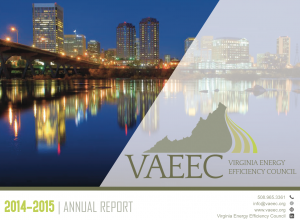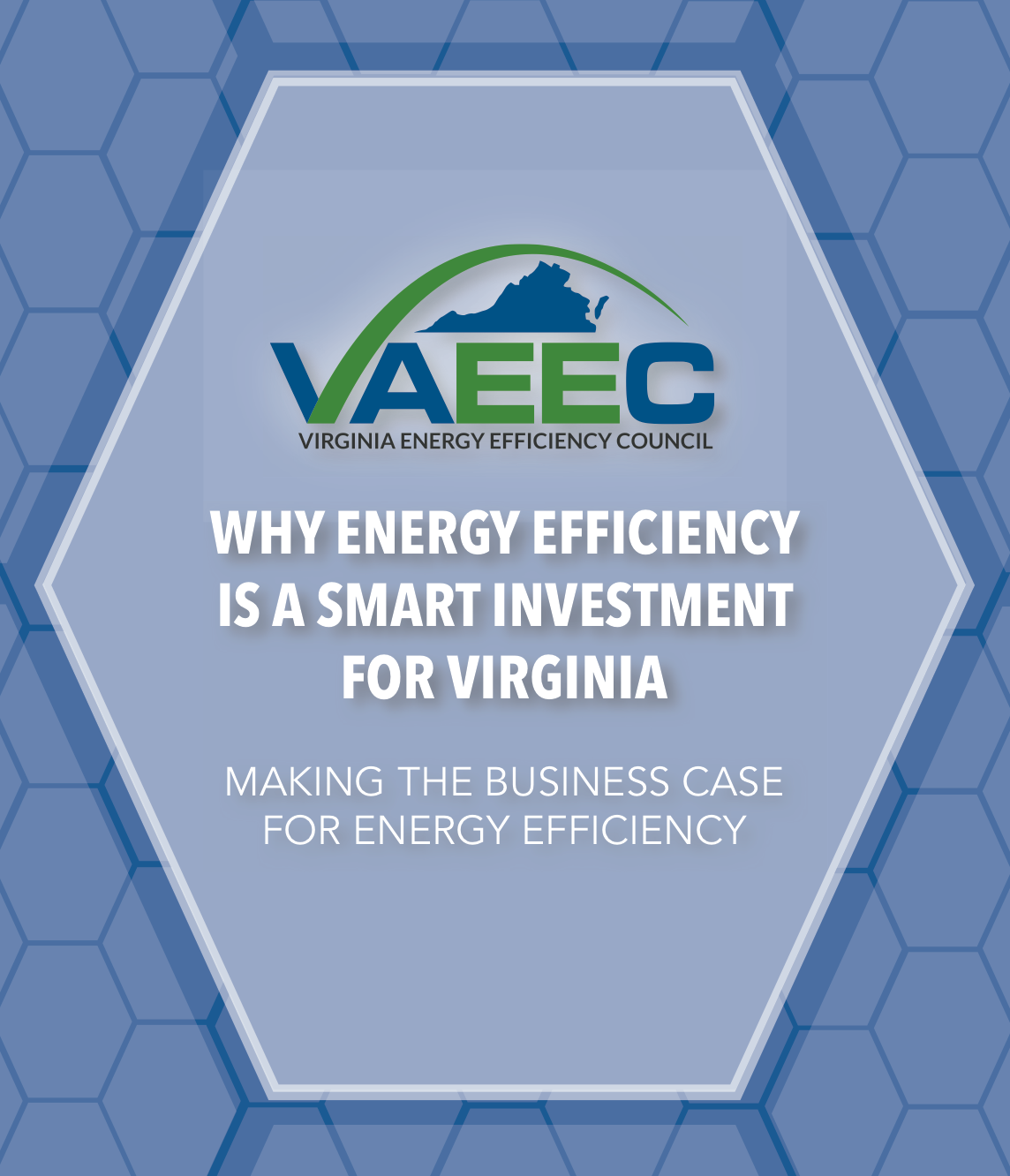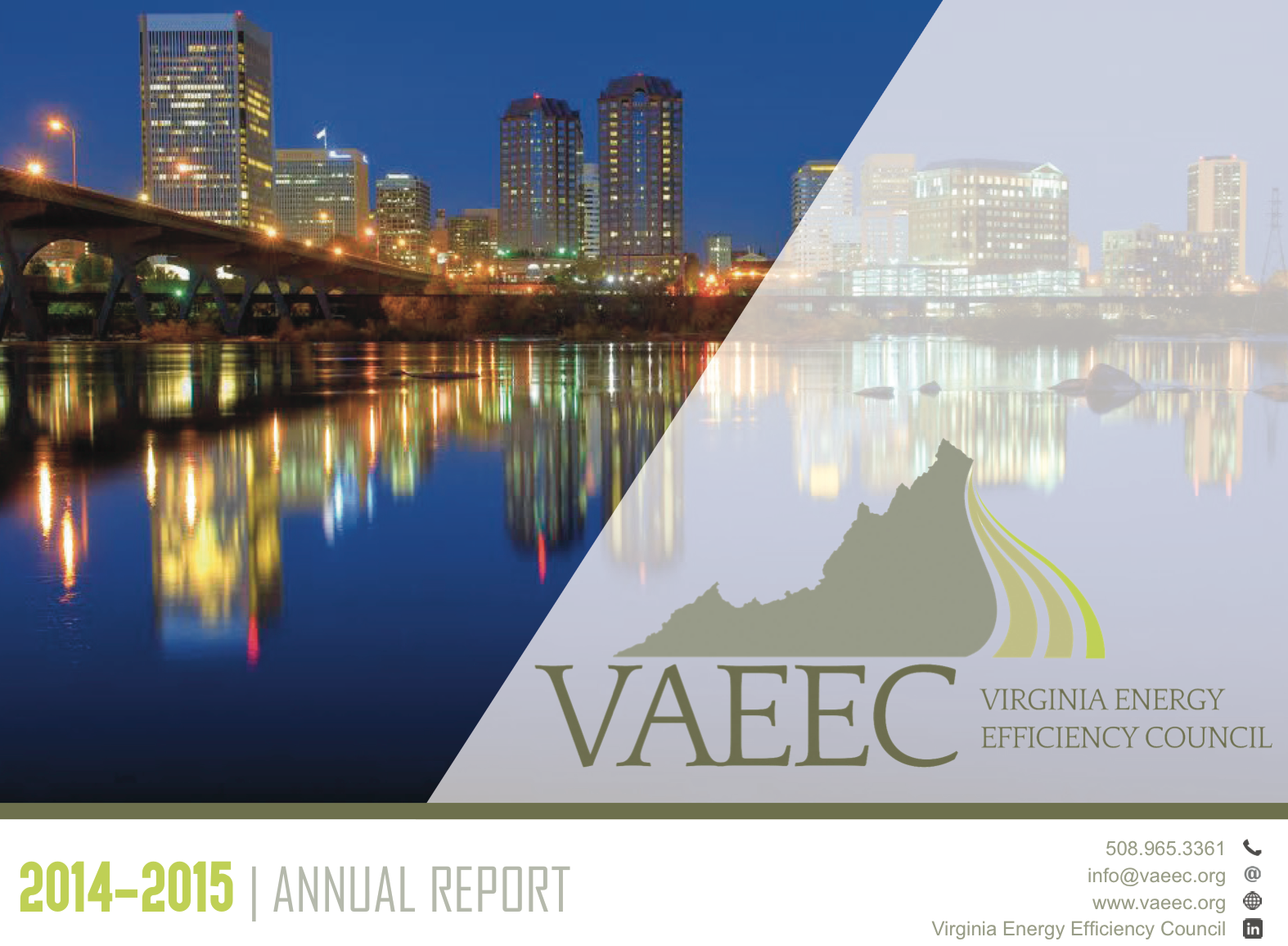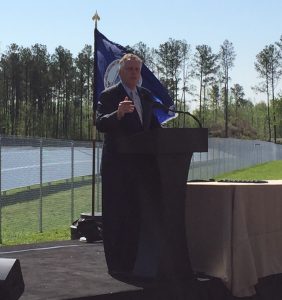Virginia Hits Energy-Efficiency Milestone
Ranks No. 1 in South, Breaks into Top 25 in New Ranking
The Virginia Energy Efficiency Council heralds a new research report, released today, that names Virginia as the regional leader of the South for its energy efficiency practices.
Virginia had its best year on the annual State Energy Efficiency Scorecard, a nationwide analysis of states based on “their policy and program efforts to save energy and pursue efficiency as a cost-effective, critical tool for slashing emissions and meeting state clean energy goals.”
“We’re thrilled to see Virginia named as a state to watch and break into the Top 25,” said Chelsea Harnish, executive director of the Virginia Energy Efficiency Council (VAEEC). “This is a reflection of the hard work that went into passing the Virginia Clean Economy Act and the efforts of the energy efficiency industry in the Commonwealth.”
The annual scorecard is published by the American Council for an Energy-Efficient Economy and can be found at aceee.org. Among the report’s findings:
“Virginia was among the top energy stories of 2020, creating its first-ever clean energy standard and becoming the first state in the Southeast with a 100% clean electricity goal. The Virginia Clean Economy Act also established an energy efficiency resource standard that sets multiyear electric savings targets for utilities and includes important measures to support low-income customers and reduce energy burdens. The governor also signed HB 981, making Virginia the first southern state to join RGGI, with proceeds going toward energy efficiency, renewable energy, and climate mitigation measures.”
Industry Often in the Shadows Drives $1.5B in Revenue and 75,000 Jobs
Richmond, Virginia (May 19, 2017) — Virginia’s economy is stronger thanks to the role of energy efficiency, according to a new report released today by the Virginia Energy Efficiency Council (VAEEC) that finds the industry drives $1.5B in annual revenue and accounts for more than 75,000 jobs. The full report, “Why Energy Efficiency is a Smart Investment for Virginia,” is available at www.vaeec.org/data and was presented at the VAEEC spring meeting in Richmond. The report lays out five specific policy recommendations that will not only help the industry continue to grow but will also play a role in future carbon reduction strategies the Commonwealth may pursue.
“With uncertainty about the future of energy efficiency policies and resources at the federal level, it is more important than ever for states to recognize the enormous potential of energy efficiency to advance smart energy solutions,” said Chelsea Harnish, VAEEC Executive Director. “The VAEEC’s 80+ members prove to us everyday that energy efficiency has tremendous potential to drive economic growth, create jobs, shrink utility bills, conserve natural resources, and reduce pollution. Our report outlines an ambitious plan to tap that potential.”
In 2013, the VAEEC released the first-ever census report documenting the energy efficiency industry in the Commonwealth. Our newest report shows that revenue generated from the energy efficiency sector has grown from nearly $300 million in 2013 to $1.5 billion in 2016. The U.S. Department of Energy has found that the industry is responsible for 75,000 jobs across the state.
The report offers five policy recommendations, specifically addressed to the incoming Governor, deemed “the smartest, fastest, most effective routes we can take to put Virginia on the path toward a clean energy future and stronger economy.” They are:
- Expand utility energy efficiency program opportunities in Virginia
- Support the adoption of Commercial Property Assessed Clean Energy (C-PACE) financing across the Commonwealth
- Adopt rigorous energy building codes for new home construction without weakening amendments
- Expand performance-based contracting for state-owned buildings and public institutions of higher education
- Provide and support opportunities for benchmarking of state, local and commercial buildings
According to the most recent update to the Virginia Energy Plan, each of these policy recommendations are critical for Virginia to meet our energy efficiency goal of 10% electricity savings by 2022. The final report from the Executive Order 57 Working Group, which was released this week as well, also highlights the the important role energy efficiency can play in reducing carbon pollution. Two of the five recommendations made by the Working Group are specific to the energy efficiency industry: 1) Updating state building codes to reflect current technology and standards and 2) Developing an energy efficiency accounting and registry tool.
The report pairs each recommendation with a case study of that policy in action, including:
- Project:HOMES weatherized a veterans housing complex in Richmond through Dominion’s Energy Share program
- The Virginia Center for Housing Research at Virginia Tech found that multi-family apartments that were built to EarthCraft, above building code, standards saved families $650 a year.
- The Virginia Department of Corrections integrated Energy Performance Contracting into their building operations to cut costs
- A Property Assessed Clean Energy (PACE) financed project at a retirement community in neighboring Kentucky is expected to achieve 37% energy savings
- In Arlington County, commercial property owners participated in a voluntary benchmarking program competition, which resulted in millions of dollars in cost savings
“This report should open a dialogue among energy efficiency stakeholders, policymakers, regulators, businesses, and local and state government agencies about how best to augment the implementation of energy efficient technologies and services,” said David Steiner of D+R International and Chair of the VAEEC Board of Directors. “The many benefits to consumers, property owners, ratepayers, local and state governments, and industry warrant aggressive adoption of best practices to implement energy efficiency throughout the Commonwealth, from the kitchen electrical outlet to the power grid.”
Contact: Chelsea Harnish, VAEEC, 804.457.8619
 Download the full Annual Report.
Download the full Annual Report.
The 2014 – 2015 membership year saw the Virginia Energy Efficiency Council make great strides towards its goal of growing the energy efficiency industry in the Commonwealth. Not only did we initiate and facilitate successful conversations on policy and regulation, we were also very pleased to see some of our long-held recommendations implemented by Virginia’s new Governor in the updated Virginia Energy Plan.
One recommendation was for the formation of a stakeholder group to identify where we stood with respect to: our state’s voluntary energy efficiency goal, how it was going to be tracked, and what the plan
was to achieve it. The appointed Governor’s Executive Committee on Energy Efficiency is just the kind of stakeholder group needed, and we welcome its mandate to assist the state in meeting the voluntary goal through an actionable plan. Four of the VAEEC’s Governance Board Directors participate on the Committee, and other Directors participate in subcommittees to support the GEC’s work.
The VAEEC is also proud to have been part the state energy office’s winning proposal team on a Dept. of Energy State Energy Program grant. As a subrecipient on this award, we will support the GEC’s efforts as a convener, technical assistance provider, and sounding board for policies and implementation strategies.
Lastly, the VAEEC thanks its primary funder, the Energy Foundation for its continued support and guidance. We have leveraged its grant many times over through our partnerships, proposals, and programs – and are very grateful for the capacity it gives us.
Warm regards to our members and fellow energy efficiency supporters,
Cynthia Adams, VAEEC Governance Board Chair
CEO, Pearl National Home Certification
October 27, 2015 — The VAEEC is pleased to welcome Chelsea Harnish as Executive Director. She takes the helm on November 2. Members and other stakeholders are invited to meet Chelsea at the VAEEC meeting on November 12.
Chelsea brings an extensive network of contacts working on clean energy and energy efficiency in the Commonwealth, a rich history of engaging with state agency staff, industry and utility representatives, and a decade’s experience in energy policy and the nonprofit sector.
 She comes to the VAEEC from the Virginia Conservation Network where she helped partners working on climate and energy issues strategically plan their approaches to achieving their collective goals. She also served as the Virginia Policy Coordinator for the Chesapeake Climate Action Network and played a variety of roles with a small nonprofit on Cape Cod in Massachusetts advocating for the Cape Wind project, America’s first announced offshore wind project.
She comes to the VAEEC from the Virginia Conservation Network where she helped partners working on climate and energy issues strategically plan their approaches to achieving their collective goals. She also served as the Virginia Policy Coordinator for the Chesapeake Climate Action Network and played a variety of roles with a small nonprofit on Cape Cod in Massachusetts advocating for the Cape Wind project, America’s first announced offshore wind project.
“I look forward to continuing to work in the energy sector in this new capacity,” said Chelsea. “Energy efficiency is a vital component to energy policy discussions and the Virginia Energy Efficiency Council plays a crucial role in supporting programs and policies that advance energy efficiency in Virginia.”
“As Virginia develops plans for federal Clean Power Plan compliance and meeting the state’s voluntary energy efficiency goal, the energy efficiency industry is poised to take center stage. It’s a crucial moment for the businesses, local and state government, and utilities we represent. Chelsea has the experience and expertise to position the VAEEC and its members at the forefront of this opportunity,” said Cynthia Adams, VAEEC Governance Board Chair.
by Ken Rosenfeld, Executive Director
There’s been growing momentum in the past few years for energy efficiency, along with a mounting wave of evidence related to its benefits and its potential. Perhaps that’s why it’s headline-inducing when a piece of news goes in the other direction. That was the case earlier this summer when an economics research paper was released by the University of Chicago. It asked in its title, “Do Energy Efficiency Investments Deliver?” and the report responded with a conclusion that the costs outweigh the benefits.
I hesitate to even mention this paper and bring any additional attention to it, as the research has been quickly, thoroughly and appropriately debunked. But at the same time, it serves as a worthwhile reminder that, despite all of the evidence in support of efficiency programs, we still need to continue making the argument that EE benefits are real.
The paper has clear shortcomings, with a number of questionable assumptions including how to measure costs, what should be included as benefits, and which populations are targeted. The primary danger is that this analysis of one program (the Weatherization Assistance Program) in one state (Michigan) could lead to far-reaching, negative conclusions on EE more broadly.
A number of highly-regarded organizations responded, representing a variety of perspectives, and these blog posts are worth a read:
We’re on the cusp of an energy efficiency moment in the U.S., and that’s particularly the case in Virginia where in just the last year we’ve seen:
- Governor McAuliffe’s formation of a committee to address the state‘s longstanding goal of reducing energy use by 10%;
- The appointment of the country’s first state-level chief energy efficiency officer;
- Bipartisan passage of Property Assessed Clean Energy (PACE) financing legislation; and
- Continued growth of the VAEEC’s membership and the energy efficiency industry – the latest VAEEC census reveals a $2.2 billion EE industry in Virginia supporting more than 13,000 jobs.
However, we haven’t reached the point where we can assume that everyone recognizes the value of energy efficiency, and we have to continue to build this consensus in order to turn the promise of EE into reality. This one research paper may have its faults – and it does — but it has served as a useful call to action.
Monday, August 3, 2015
This afternoon, the U.S. Environmental Protection Agency released its long-anticipated final rule on the Clean Power Plan (CPP), a federal initiative for curbing greenhouse gas emissions from power plants. The CPP calls for a significant reduction in carbon emission from the nation’s power sector – a 32 percent reduction below 2005 levels by 2030. The CPP sets state-by-state targets for emission reductions and allows states to develop their own compliance plans. Details can be found here.
Statement by Ken Rosenfeld, executive director of the Virginia Energy Efficiency Council:
“After much anticipation, the Clean Power Plan is here and the Virginia Energy Efficiency Council (VAEEC) recognizes this as an opportunity to plan for the future and make sensible energy decisions.
While the Clean Power Plan has generated plenty of debate, it’s time now for Virginia to prepare a comprehensive strategy to address the plan’s goals. To that end, the VAEEC strongly encourages Virginia to include a robust role for energy efficiency in its compliance plan. Energy efficiency can help meet the federal guidelines while concurrently generating significant economic and environmental benefits for Virginians.
There are a few specific items in the final rule that deserve particular mention:
- Energy efficiency is no longer specified as a “building block” – a category used by the EPA to calculate the emissions reduction targets. This is a technical change that was reportedly made to address legal concerns, but it’s important to note that it does not affect the significance of energy efficiency as one of the primary compliance tools available to states to meet their targets.
- It specifically creates a Clean Energy Incentive Program, which offers credits to states that implement energy efficiency programs in low-income communities.
- It allows states to request extensions for submitting their implementation plans, and extends the deadline to begin the compliance period from 2020 to 2022; this development provides the time needed to develop thoughtful and comprehensive plans, and allows for careful consideration of how energy efficiency will be incorporated.
We know that an increased emphasis on energy efficiency needs to be part of any comprehensive approach. Energy efficiency is a rare “win-win” in energy policy, a common sense, nonpartisan, and cost-effective solution:
- It’s the lowest-cost resource option to meet Virginia’s energy supply needs,
- It’s the cleanest option as it represents energy that’s not consumed,
- Through demand reduction it improves our energy system by reducing risk and increasing reliability, and
- It promotes local economic development and job creation – an industry census performed by the VAEEC reveals a $2.2 billion energy efficiency industry in Virginia supporting at least 13,000 jobs at more than 500 firms.
The VAEEC represents a wide range of perspectives, and we look forward to working with the McAuliffe Administration, state agencies, policymakers and our many partners as Virginia devises the best path forward to meeting the Clean Power Plan goals.”
The Virginia Energy Efficiency Council (VAEEC) is a broad coalition working to assess and support innovative programs, policies and best practices that encourage energy efficiency in the Commonwealth and to provide a forum for stakeholder interaction. The VAEEC is a 501(c)(3) nonprofit organization whose membership includes businesses of all sizes, utilities, nonprofit and advocacy organizations, local governments and state agencies. For more information, visit www.vaeec.org.
Governor McAuliffe chose Earth Day 2015 as the fitting time to sign several pieces of clean energy legislation into law, including a pair of bills promoting energy efficiency. The VAEEC was well-represented at the event with a number of member representatives joining the celebration. The new clean energy laws include two VAEEC priorities: Property Assessed Clean Energy (PACE) financing, and a clarification to the Conservation and Ratemaking Efficiency (CARE) Act which regulates the state’s natural gas utilities.
The PACE legislation is the culmination of many years of work to have Virginia join the majority of states that have successfully implemented the program. PACE is a loan program that can be implemented by localities, allowing commercial property owners to finance energy efficiency and renewable energy measures for their properties and repay the loans as special assessments. VAEEC Board Member Bill Greenleaf of Virginia Community Capital spearheaded the successful campaign.
Read the final language.The update to the CARE Act clarifies how efficiency programs proposed by the gas utilities are evaluated by the State Corporation Commission. The change, supported by the utilities and the SCC, promises to result in more robust efficiency program offerings for Virginia customers.
Read the final language.
“The VAEEC thanks the Governor, his Administration, the bill sponsors, and the General Assembly for the great support of PACE financing and the CARE Act fix,” said Ken Rosenfeld, Executive Director of the VAEEC. “Both bills were overwhelmingly passed, reflecting the bipartisan support for energy efficiency in Virginia.”
“PACE financing provides a substantial new option to expand opportunities for commercial property owners. The CARE Act clarification, by providing a better measure of the true cost effectiveness of utility efficiency programs, promises to bring new opportunities to Virginia consumers. These two laws are a significant step forward for energy efficiency in the Commonwealth, and that means lower energy bills, cleaner air and local jobs. We have much more to do to reach the state’s energy goals, but this year’s General Assembly session was a home run for energy efficiency.”
The two new laws will be featured topics of discussion at the VAEEC Spring Meeting, Monday, May 11, 2:00-5:00pm, at the Science Museum of Virginia in Richmond. Register now.
October 20, 2014 — Virginia Governor Terry McAuliffe last week issued Executive Order 31 to reduce energy consumption in state government, saying “Reducing energy consumption in state government will save taxpayers money, strengthen our energy efficiency industry and decrease Virginia’s greenhouse gas emissions. It will also set an example for businesses and families of steps that we can all take to make Virginia the most energy efficient state in the nation.”

Jason Hartke of the US Green Building Council (L) and Ken Rosenfeld of VAEEC (R) congratulate Hayes Framme on his appointment as Chief Energy Efficiency Officer for the Commonwealth of Virginia
As part of the executive order, the Governor appointed Hayes Framme as Chief Energy Efficiency Officer, possibly the first state-level position of its kind in the country. Mr Framme has been serving as the administration’s Advisor for Infrastructure and Development and oversaw key aspects of the development of the recently-released Virginia Energy Plan.
Statement of Ken Rosenfeld, VAEEC Executive Director
“The Virginia Energy Efficiency Council would like to thank Governor McAuliffe for creating a Chief Energy Efficiency Officer position within his administration and to congratulate Hayes Framme on his appointment to this office.
“This new position underscores the Commonwealth’s commitment to energy efficiency as a cornerstone of the 2014 Virginia Energy Plan. The state government can save millions of dollars by embracing energy efficiency in its own operations, and it is now poised to lead by example as it embarks on efforts to advance energy efficiency among homeowners and businesses.
“We welcome Mr. Framme as Chief Energy Efficiency Officer as an experienced leader who understands the tremendous potential of energy efficiency as a cost-effective resource and as an engine for economic development.
“The VAEEC looks forward to working with Mr. Framme and the administration to achieve Virginia’s energy goals. With the introduction of the new Virginia Energy Plan, Executive Order 31, and Mr. Framme’s appointment, there’s reason for great optimism for the future of energy efficiency in the Commonwealth.”
October 14, 2014 — Governor McAuliffe officially unveiled his Virginia Energy Plan at an event in Richmond today co-hosted by the Virginia Chamber of Commerce and Virginia League of Conservation Voters. Cynthia Adams, Executive Director of the Local Energy Alliance Program and Chair of the Virginia Energy Efficiency Council, was a panelist at the event. Her remarks are below.
Read the VAEEC’s press release on the Plan or download the full Plan.
http://dmme.virginia.gov/DE/2014_VirginiaEnergyPlan2.shtml
“Good morning everyone, and a special thank you to the administration for inviting me to participate on this panel. As Chair of the Virginia Energy Efficiency Council, I will tell you that a real conversation on Virginia’s energy portfolio that includes unsung heroes like energy efficiency has been a long time coming in our state.
The mission of the nonprofit I run – the Local Energy Alliance Program or LEAP based in Charlottesville — is to lead the effort to retrofit buildings with energy efficient and renewable technologies. At LEAP we like to say we’re building a virtual power plant of the present that produces negawatts instead of megawatts. Our power plant isn’t subject to a slew of environmental or statutory regulations, so we have already begun constructing it.
And our power plant is creating jobs right now – jobs today, jobs tomorrow, and jobs next week. Energy efficiency’s power plant workers are your neighbors – they are the contractors that air seal buildings and add insulation. They replace aging equipment, and install better lighting. These power plant workers correct ventilation issues that exacerbate allergies and asthma. And they make our homes more affordable, they lower operating costs for businesses, and protect tax payers from paying for energy wasted in government buildings.
Virginia is a capacity short state, which simply put, means our supply has not kept up with our demand. As a result, utilities are tasked with building more power plants because they have to – we need to keep the lights on. Our population is growing, we continue to construct more buildings, and the number of gadgets we put into these buildings is also increasing – the new power needed has to come from somewhere.
A quick physics refresher for those of us who are decades out of elementary school: coal fired power plants implement four energy conversions in order to generate an electron for the grid, and then we have the line losses that come from stepping up and down the amperage of that current flow. By the time the cfl lights up your dining room, only 5% of the original energy content from the hunk of coal is in use. So a little bit of energy saved at home makes a big difference in terms of the amount of energy that goes into the system.
Energy efficiency is in fact the original distributed energy resource when you frame the discussion from a capacity perspective. How do we create energy efficiency as a commodity, as a supply-side resource – and what does that mean really? If we know (and we do) that our need for energy is increasing, that we must build new plants in order to meet the demands of tomorrow, then energy efficiency is just another way to meet that demand. If you need less, then you build less.
Many of us here may be familiar with the multitude of benefits that come from energy efficiency, but let’s take a moment to reiterate them. Energy efficiency:
– Conserves finite resources and saves money on building power plants
– Makes our buildings more durable
– Improves comfort, quality of life, and worker productivity
– Increases our energy security
– Spurs local economic development
– Creates or maintains jobs
There are a multitude of reasons why promoting and implementing energy efficiency is in the public’s and our own personal best interests. We have study after study that has given us statistic after statistic on the economic benefits, on the business case for energy efficiency as a resource and as a means to grow jobs and save money.
Here are a couple of notable statistics from the American Council for an Energy Efficient Economy’s Energy Efficiency and the Economic Opportunity Fact Sheet: for every $1M spent in building efficiency improvements, 20 jobs are supported – this is in contrast to only 17 jobs supported by investing into the economy as a whole. And for every $1M in avoided consumer energy costs, another 17 jobs are supported. This is in contrast to only 10 jobs supported through utility generation and transmission.
Most public buildings spend 20-30% more on energy than necessary; these expenses could be “recovered” through energy upgrades at no additional cost to tax payers through work that pays for itself. It is estimated that there are over $1 billion in self-paying energy efficiency projects in public buildings alone, which would be a huge boon to the Commonwealth’s economy – creating jobs, and catalyzing workforce development.
In Virginia’s residential building sector we have roughly 1.5M homes retrofit ready homes – that is homes that are owner-occupied and built prior to 1970 (before we had insulation standards in code). A 2% market penetration of these 1.5M homes equates to roughly 30,000 upgrades annually. If the average retrofit costs $5000 and produces 15% or more in energy savings, we’re talking about leveraging $150M in private capital. And, given the job conversion factors I spoke of earlier, the Commonwealth would support an additional 3200 jobs.
State organizations like the Virginia Energy Efficiency Council will tell you that energy efficiency is important for the business case it presents. The VAEEC has completed two industry census reports on energy efficiency businesses to document the value they bring to the Commonwealth. And we look forward to the appointment of the Governor’s Energy Efficiency Board to develop a strategy on meeting our state 10% energy efficiency goal by 2020. I invite us all to remember that Virginia is a net importer of energy. Ultimately energy efficiency is about keeping Virginia dollars in Virginia, instead of sending them out of state to support someone else’s investment.
Virginia Energy Efficiency Council Applauds Emphasis on Efficiency and Conservation in Virginia Energy Plan
October 1, Richmond — The Virginia Energy Efficiency Council (VAEEC) applauds Gov. Terry McAuliffe’s Virginia Energy Plan, released on October 1. As the Governors says in his opening letter, “the cleanest and cheapest energy is the energy that is not consumed,” underscoring the central role energy efficiency will play in the Commonwealth’s energy future.
The plan is intended to provide a strategic vision for energy policy in Virginia, providing a comprehensive view of current assets and future opportunities.
“The VAEEC is pleased that the new plan identifies energy efficiency as a leading solution to many of the challenges we face in Virginia,” said Ken Rosenfeld, executive director of the VAEEC. “This is great news as we look toward the future and plan to meet the energy needs of the Commonwealth. We thank Gov. McAuliffe, the Department of Mines, Minerals, and Energy (DMME), and the Virginia Energy Council (VEC) for identifying energy efficiency as the most cost effective energy resource and as an engine for economic development.”
Energy efficiency and conservation are highlighted as a separate section in the plan, which includes the following statements:
• “Energy efficiency and conservation offer Virginians the most cost-effective and most readily deployable method to manage the Commonwealth’s energy future.”
• “The efficient use of energy results in decreased use of resources, less air pollution, and therefore, cost savings.”
The related recommendation in the plan is to “Make Virginia a Leader in Energy Efficiency to Reduce Consumption and Spur Economic Growth.” Five associated initiatives are identified:
• Establish a Virginia Board on Energy Efficiency that will develop a strategic plan to achieve the voluntary state goal of reducing energy consumption by 10% by 2020.
• Aggressively implement energy efficiency in state government.
• Develop a marketing, outreach and preliminary assistance program to engage local municipalities in Energy Performance Contracting (EPC).
• Create a central state facility energy data registry and dashboard to track energy consumption at all state agencies.
• Engage social entrepreneurs in exploring and implementing innovative models, such as pay for performance, in order to test new and innovative ways to cut energy bills and to finance energy efficiency upgrades in existing multi-family residential properties.
Many of the recommendations are consistent with input provided by the VAEEC during the public outreach portion of the plan’s development. The VAEEC recommended convening a group similar to the proposed Virginia Board on Energy Efficiency and recommended an expansion of performance contracting in government buildings. The VAEEC also called for energy efficiency to be recognized for the first time as a separate section in the plan, placing it on equal footing with other energy sources.
“This Energy Plan echoes the recommendations made by the VAEEC and provides momentum for achieving some real progress on energy efficiency in Virginia,” said Rosenfeld. “We look forward to working with the administration, policymakers, and all stakeholders to make these goals a reality. Our membership is poised to bring a wealth of experience and enthusiasm to meeting Virginia’s energy challenges.”
The VAEEC was tapped by the administration to present at each of the listening sessions convened across the state to gather input during development of the plan. The Chair of the VAEEC, Cynthia Adams, was appointed by the Governor to serve on the Virginia Energy Council, representing both the VAEEC and the nonprofit Local Energy Alliance Program (LEAP). The VEC provided feedback to DMME throughout the plan’s creation.
The Energy Plan, which will be formally presented at an event October 14, will be explored in detail as a featured agenda item at the VAEEC Fall membership meeting, which will be held two days later on October 16, 2:00pm, at the Science Museum of Virginia in Richmond. The meeting is open to everyone; click here to register.
The VAEEC is a broad coalition working to assess and support programs, innovation, best practices and policies that grow Virginia’s energy efficiency industry and to provide a forum for stakeholder interaction. The membership includes businesses of all sizes, utilities, nonprofits, universities and local governments.







